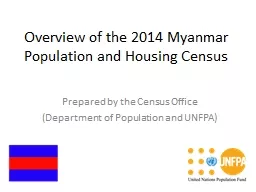

Prepared by the Census Office Department of Population and UNFPA Introduction What is Census The process of collecting compiling evaluating analyzing and disseminating demographic economic and social data pertaining to all persons in a country at a specified time ID: 527468
Download Presentation The PPT/PDF document "Overview of the 2014 Myanmar Population ..." is the property of its rightful owner. Permission is granted to download and print the materials on this web site for personal, non-commercial use only, and to display it on your personal computer provided you do not modify the materials and that you retain all copyright notices contained in the materials. By downloading content from our website, you accept the terms of this agreement.
Slide1
Overview of the 2014 Myanmar Population and Housing Census
Prepared by the Census Office(Department of Population and UNFPA)Slide2
Introduction
What is Census?
The process of collecting, compiling, evaluating, analyzing
and
disseminating demographic, economic and social data pertaining to all persons in a country, at a specified time.United Nations
2Slide3
The Census Cycle
PREPARATION
FIELD OPERATIONS
EVALUATION
DISSEMINATION
DATA PROCESSING
PLANNINGSlide4
Preparation PhaseSlide5
5
Mapping and Enumeration
Area (EA) Demarcation
Aim is to ensure complete coverage of all dwelling units and to avoid overlaps
Maps drawn by Township Immigration Officers, reviewed and approved at DOP
Each
EA
was assigned
a unique code number composed of
12 digits, identifying the State/Region, District, Township, Ward/VT, EA
Each EA had about 120 householdsSlide6
Examples of Census Maps
EA Map
Supervisor MapSlide7
Development of Census Questionnaire
Developed in consultation with potential data usersIn line with Principles and Recommendations of the 2010 Round of Censuses
Two questionnaires developedMain Questionnaire: 41 questionsInstitution Questionnaire: 11 questionsTopics included sex, age, marital status, ethnicity, religion, disability, migration, education, labour force, children ever born, housing conditions and household amenities, household members abroad and Deaths during last 12 months in the household Slide8
8
Sample questionnaire
Household identification
Information on Each Individual MemberSlide9
Publicity/Advocacy
Pamphlets – 17 languagesPosters – 1 million in different languages and sizesHandbook – 11 languagesQuestion and Answer – 11 languages
Radio, TV, Social mediaBill boardsBus Tours with celebritiesT-shirts, caps/hats, bangles, hand fansTownhall meetings with ethnic leadersSlide10
Advocacy/PublicitySlide11Slide12
Training materials
Field Instructions Manual
Training Guide for training Master Trainers and District TrainersTraining Guide for Training of EnumeratorsTraining Guide for Training of SupervisorsGuide for State and Township CommitteesTraining Aids –
DVDs, role
plays, power point/flip charts,
quizzesSlide13
Training
More interaction – communication and ways of asking questions3 trainers per venueMedium sized class of 40 – 50 peopleTrainers were mostly teachersSlide14
Training of Enumerators and Supervisors (120,000)Slide15
Field OperationsSlide16
Field Enumeration
From 30 March to 10 April 2014About 80,000 enumerators and 40,000 supervisors were deployed across the country
Started by updating Structures to improve coverageSupervisor re-checked 3 households in every EASupport Group to ensure every household/people collectedA team of 47 independent observers (23 international, 24 national) carried out observation in all States and DivisionsSlide17Slide18Slide19
Post-enumeration activitiesSlide20
Receiving (Accounting for materials)
Township Immigration Officers came to DOP to account for all Enumeration Areas and materials sent to them
Control list of EAs was developed to ensure all questionnaires were received backEach State/Region was allocated a particular date20Slide21
Receiving process
21Slide22
Preparation for Scanning
Questionnaires were prepared for scanning in order to ensure good quality
scanning:Counting the questionnaires to ensure they reconcile with the receiving teamChecking to confirm that all the questionnaires in the box belong to the same EA, and that there are no “stray” questionnairesTranscribing any soiled, torn or mutilated questionnaires (which may not pass through the scanner)
Checking that there are no missing or duplicate
households
Splitting the questionnaires from A3 size to Legal size, so that they can pass through the scanner.22Slide23
Registration and scanning
Registration: First step in making the system aware that Census questionnaires have
been received from an EAEach batch of questionnaires must be identified to the system so that scanning and further processing can be done. 23Slide24
Typical batch registration screen
24Slide25
Character Inspection: Examining characters in bulk
25Slide26
Coding of Occupation and Industry
Occupation and Industry written as free text during enumeration, hence cannot
be captured using OMR or ICR technologyEnumerators wrote the description of the Occupation and Industry in the questionnaireCensus Office developed the coding index for occupation and industry based on ISCO 2008 and ISIC version 4To improve quality of coding, each
questionnaire is being coded by two
operators
(“double-blind” coding). If the two operators have coded differently, the questionnaire automatically goes to the Supervisor to make a determination on the correct code.26Slide27
A typical operator coding screen
27Slide28
A typical Supervisor coding screen
28Slide29
Methods of Editing data
- Structural
Geography Code use information on same batch Urban/rural – hot deck from preceding household EA codeHousehold does not contain any person – delete the records Invalid household Number – create new one
29Slide30
Structural Edits
Multiple households merged – separate to different householdsFor personal records age, sex and relationship
Fertility data is filled against man in household30Slide31
Attribute Editing
Not stated/Out of rangeImpute if case is less than 0.5%
Leave the cases as they are to be presented as not statedHighest Level of Education completed Child aged 9 years attended university given highest level of education possible for the person Children Ever Born: Total = in household + away + dead
31Slide32
Thank You!!